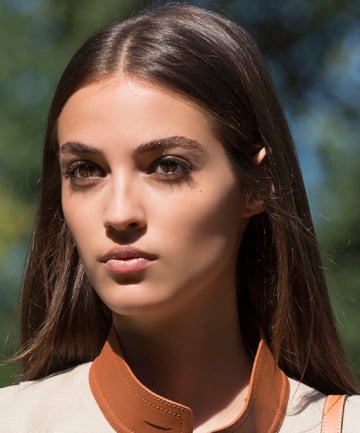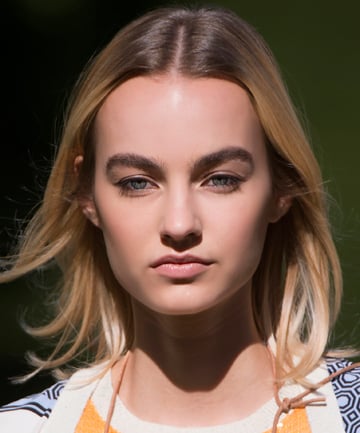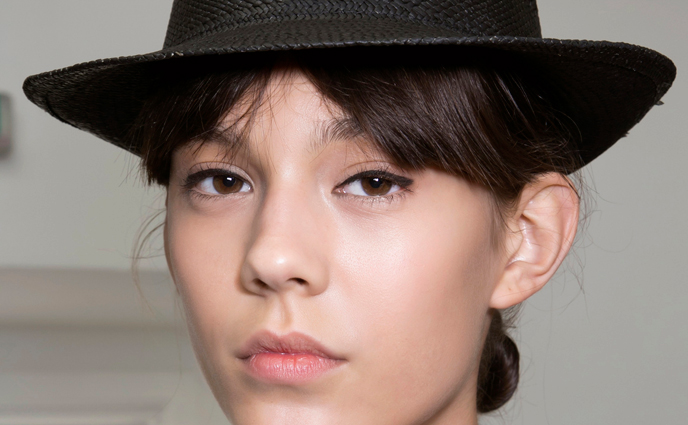"People ask me all the time what's the best sunscreen and it's really the one you're going to use every day," advises Levin. Whether it's a physical sunscreen or a chemical one, she just wants you to use it. "I suggest broad-spectrum and that it be SPF 30 or higher. I tend to prefer a physical sunscreen for people with skin sensitivity and skin conditions like rosacea, but there are plenty of good chemical sunscreens out there that are well tolerated as well."
Now, let's talk about some best practices for sunscreen application.
Image via Imaxtree
Now, let's talk about some best practices for sunscreen application.
Image via Imaxtree
Here are some general rules for sunscreen application:
Apply enough
"That means a whole tablespoon for the face and neck, and enough to fill a shot glass to cover the entire body," Levin says.
Reapply
The most common mistake most of us make is we put it on and never think about it again. Wrong. "Sunscreens typically only last 40 to 80 minutes, so that means if you're going to be outside or outdoor activities where you're sweating, you've got to reapply. That means having a conveniently sized sunscreen bottle that you can put in your backpack or purse so you can reapply," Levin says. Even if you're just heading out for your lunch break or to run errands, if you're going outside and it's daylight (even cloudy days count), that means reapply.
Going outside? Prep before
"If you're going to be outside, apply your sunscreen like a body lotion: right out of the shower and over your entire body before you get dressed," Levin says.
Also, don't forget the "forgotten areas"
"Obviously, if your toes are going to be exposed, you want to make sure you put sunscreen between them and on your feet," Levin cautions. "There are more concerning types of skin cancers like acral letiginous melanoma (ALM), which means they're melanomas that happen on the palms and soles and can be a lot more aggressive. It's important to protect those areas people don't always think about."
It's also important to protect the ears and the scalp, which is an area where skin cancers tend to be pretty aggressive and invade more quickly. Protecting the ears and the scalp are super important, especially in men who don't typically have hair that covers their ears and may not have as much hair to cover their scalps. Same thing with women: hair thinning is a natural part of aging in both men and women. So wearing hats can be super helpful to protect the head," she adds.
Image via Imaxtree
Apply enough
"That means a whole tablespoon for the face and neck, and enough to fill a shot glass to cover the entire body," Levin says.
Reapply
The most common mistake most of us make is we put it on and never think about it again. Wrong. "Sunscreens typically only last 40 to 80 minutes, so that means if you're going to be outside or outdoor activities where you're sweating, you've got to reapply. That means having a conveniently sized sunscreen bottle that you can put in your backpack or purse so you can reapply," Levin says. Even if you're just heading out for your lunch break or to run errands, if you're going outside and it's daylight (even cloudy days count), that means reapply.
Going outside? Prep before
"If you're going to be outside, apply your sunscreen like a body lotion: right out of the shower and over your entire body before you get dressed," Levin says.
Also, don't forget the "forgotten areas"
"Obviously, if your toes are going to be exposed, you want to make sure you put sunscreen between them and on your feet," Levin cautions. "There are more concerning types of skin cancers like acral letiginous melanoma (ALM), which means they're melanomas that happen on the palms and soles and can be a lot more aggressive. It's important to protect those areas people don't always think about."
It's also important to protect the ears and the scalp, which is an area where skin cancers tend to be pretty aggressive and invade more quickly. Protecting the ears and the scalp are super important, especially in men who don't typically have hair that covers their ears and may not have as much hair to cover their scalps. Same thing with women: hair thinning is a natural part of aging in both men and women. So wearing hats can be super helpful to protect the head," she adds.
Image via Imaxtree






